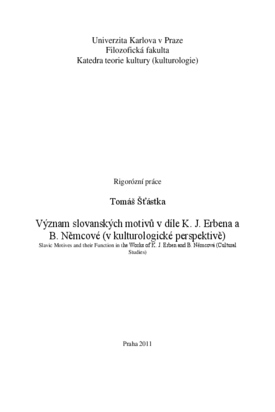Význam slovanských motivů v díle K.J. Erbena a B. Němcové (v kulturologické perspektivě)
Slavic motives and their function in the works of K.J. Erben and B. Němcová (cultural studies)
rigorózní práce (NEOBHÁJENO)

Zobrazit/
Trvalý odkaz
http://hdl.handle.net/20.500.11956/47377Identifikátory
SIS: 97265
Katalog UK: 990014287230106986
Kolekce
- Kvalifikační práce [24984]
Autor
Oponent práce
Soukup, Martin
Rychlík, Martin
Fakulta / součást
Filozofická fakulta
Obor
Kulturologie
Katedra / ústav / klinika
Ústav etnologie
Datum obhajoby
15. 11. 2011
Nakladatel
Univerzita Karlova, Filozofická fakultaJazyk
Čeština
Známka
Neprospěl/a
Cílem práce je vysledovat původní slovanskou mytologii v popisu literárních postav našich dvou předních pohádkářů. Pokusíme se zjistit, nakolik jsou obecné vlastnosti pohádkových postav moderním konstruktem spisovatelů a nakolik jsou dosud přežívajícím zbytkem původní slovanské pohanské víry. V první části práce se budeme věnovat rozboru nejvýznamnějších pohádkových děl Karla Jaromíra Erbena a Boženy Němcové. Měl vliv na dnešní vnímání pohádkových postav jejich cílený sběr lidové slovesnosti či spíše jejich vlastní umělecké představy? Následující kapitoly jsou věnovány dosud známým poznatkům a závěrům slovanského pohanství, odkud se dostáváme k výčtu a popisu jednotlivých bohů a démonických postav. Vzhledem k fatálnímu významu procesu christianizace se krátce podíváme i na kulturně-historický vývoj Velké Moravy, který je z hlediska středoevropského regionu neopomenutelný.
The thesis focuses on identifying the traces of original Slavonic mythology in the works of two Czech forefront fairy-tales collectors, Karel Jaromír Erben and Božena Němcová. The aim of the thesis is to answer the following question: Are the general characteristics of the depicted supernatural beings the result of writers' imagination, or are they the remains of much older, yet still present pagan tradition? First part of the thesis presents an analysis of the most important works of Erben and Němcová. Regarding the contemporary understanding of their work, this part questiones the significance of writers' own preconceptions on one side, and the importance of the persisting remains of pagan tradition on the other, and discusses the resulting image and our contemporary understanding of the work. Following chapters summarize current knowledge of Slavonic paganism and describe its particular figures and deities. Due to the consequences of christianization, as well as its historical role in the development of Central Europe, final part of the thesis briefly sums up the culture and history of Great Moravia.
